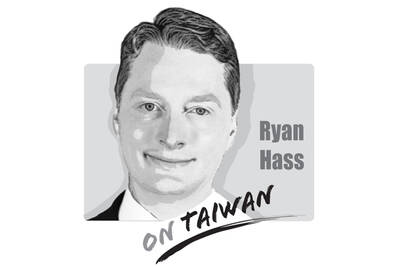Every year, local governments across the nation decorate the streets with light installations to celebrate the Lantern Festival, with Taipei this year hosting the main event. However, one of the lantern displays in the capital has triggered debate and criticism.
The work is composed of major characters from the Chinese classic Journey to the West (西遊記). What was striking is its depiction of a white rabbit — to represent the Year of the Rabbit — sitting in a boiling twin-side hot pot surrounded by the Bull Demon King and Tang Sanzang. Many visitors found the “rabbit boiling” scene disturbing and appalling.
The installation’s organizer, the Chinese Artistic Lantern Association, said that the rabbit was “not being boiled,” but is “bathing happily in a hot spring,” and that the overall scene was meant to convey harmony and happiness. Nonetheless, a few days later, the rabbit was removed from the installation, with many Internet users joking that it had “finally been gobbled up.”
Another work that attracted criticism was a large installation near the Sun Yat-sen Memorial Hall depicting two large Chinese dragons perching on a gate. Many Internet users found it gaudy and said it was a classic example of “ROC aesthetics.”
The phrase “ROC aesthetics” originally referred to the style of buildings constructed after the Chinese Nationalist Party (KMT) retreated to Taiwan. As most of the buildings were built in haste and without any attention to aesthetics, the term has come to refer to anything that looks jumbled, loud, tawdry and influenced by gaudy elements of Chinese culture. More often than not, it stands for bad taste and a lack of aesthetic quality. In short, an aesthetic fiasco.
These examples of ROC aesthetic catastrophes are a result of the extreme distortion of aesthetics, history and memory under the autocratic rule of the past KMT regime. Textbooks were filled with information about Chinese geography, history and literature. As a result, Taiwanese were more familiar with aspects of China than with the land on which they were born and live. Students are likely to be more familiar with scenes in Journey to the West than they are with Taiwan’s indigenous folklore.
The legacies and aesthetic catastrophes left behind by the regime extend to the marginalization of Taiwan’s local languages, an overabundance of political slogans, and numerous statues of former presidents Chiang Ching-kuo (蔣經國) and Chiang Kai-shek (蔣介石) littered across the nation, as well as untidy, chaotic streetscapes.
Former Kaohsiung mayor Han Kuo-yu (韓國瑜) is perhaps the epitome of ROC aesthetics, with his tawdry slogans, politically laden singing, as well as the horrendous lantern festival held during his tenure, with visitors comparing it to a “mourning hall” with its large lotus installations and a statue of Han.
For festivals, those in power are given the discretion and judgement to put the finest art on display. In this case, the annual lantern festival and the works presented should be reflective of Taiwanese aesthetics, ideology and history. Even though it is true that when it comes to aesthetics, “beauty is in the eye of the beholder,” the overall principle should be presenting aspects closer to Taiwan’s local culture, history and values, instead of focusing on Chinese cultural elements.
As Wendell Pierce once said: “The role of culture is that it’s the form through which we as a society reflect on who we are, where we’ve been, where we hope to be.” The lantern festival is not just a festival, but a vision and reflection of Taiwanese society.

There has been much catastrophizing in Taiwan recently about America becoming more unreliable as a bulwark against Chinese pressure. Some of this has been sparked by debates in Washington about whether the United States should defend Taiwan in event of conflict. There also were understandable anxieties about whether President Trump would sacrifice Taiwan’s interests for a trade deal when he sat down with President Xi (習近平) in late October. On top of that, Taiwan’s opposition political leaders have sought to score political points by attacking the Lai (賴清德) administration for mishandling relations with the United States. Part of this budding anxiety
The diplomatic dispute between China and Japan over Japanese Prime Minister Sanae Takaichi’s comments in the Japanese Diet continues to escalate. In a letter to UN Secretary-General Antonio Guterres, China’s UN Ambassador Fu Cong (傅聰) wrote that, “if Japan dares to attempt an armed intervention in the cross-Strait situation, it would be an act of aggression.” There was no indication that Fu was aware of the irony implicit in the complaint. Until this point, Beijing had limited its remonstrations to diplomatic summonses and weaponization of economic levers, such as banning Japanese seafood imports, discouraging Chinese from traveling to Japan or issuing
Tokyo-Beijing relations have been rapidly deteriorating over the past two weeks as China tries to punish Japan over Japanese Prime Minister Sanae Takaichi’s remarks about Taiwan earlier this month, and the off-ramp to this conflict is yet to be seen. Takaichi saying that a “Taiwan contingency” could cause a “situation threatening Japan’s survival” — which would allow Japan to act in self-defense — has drawn Beijing’s ire and sparked retaliatory measures. Her remark did not gain public attention until Chinese Consul General in Osaka Xue Jian (薛劍) made an apparent threat to behead her. The two sides lodged protests against each
On Nov. 8, newly elected Chinese Nationalist Party (KMT) Chairwoman Cheng Li-wun (鄭麗文) and Vice Chairman Chi Lin-len (季麟連) attended a memorial for White Terror era victims, during which convicted Chinese Communist Party (CCP) spies such as Wu Shi (吳石) were also honored. Cheng’s participation in the ceremony, which she said was part of her efforts to promote cross-strait reconciliation, has trapped herself and her party into the KMT’s dark past, and risks putting the party back on its old disastrous road. Wu, a lieutenant general who was the Ministry of National Defense’s deputy chief of the general staff, was recruited